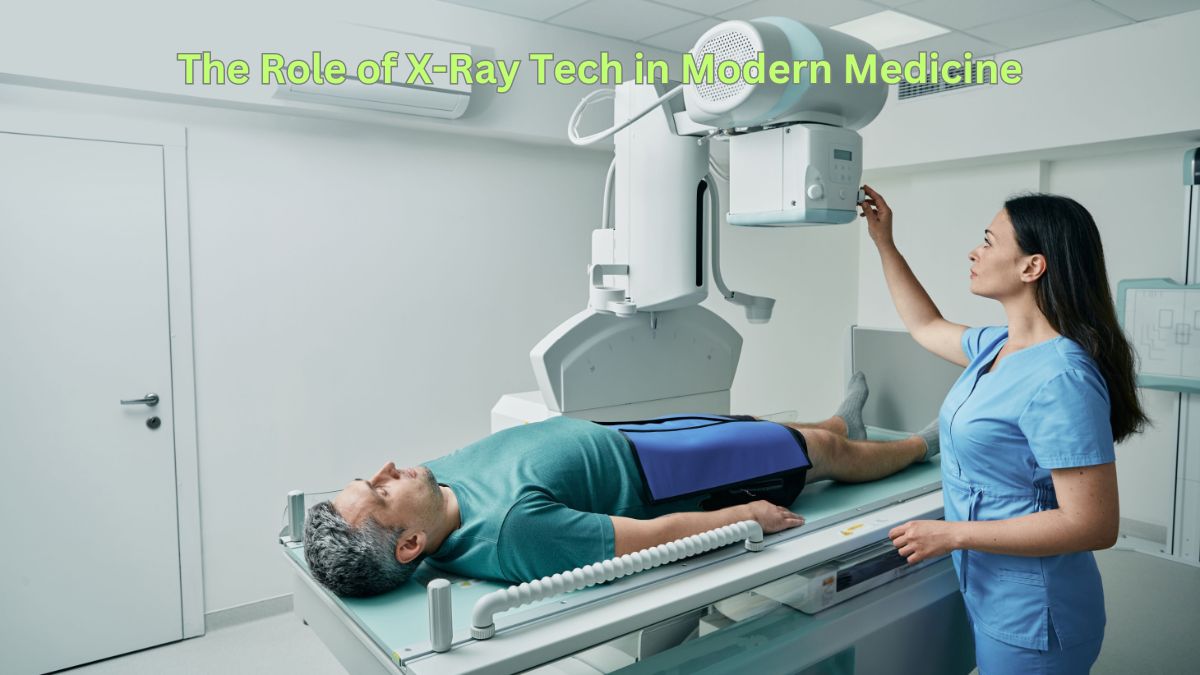Imagine peering into the human body without a single incision, unraveling mysteries hidden beneath the surface with just a flash of light. Welcome to the world of X-ray technology—a cornerstone of modern medicine that has revolutionized diagnostics and patient care. From detecting fractures and foreign objects to diagnosing complex diseases, X-ray tech serves as a crucial bridge between symptoms and solutions, empowering healthcare professionals with invaluable insights. In this blog post, we’ll delve into how these remarkable imaging techniques are not only shaping patient outcomes but also pushing the boundaries of medical innovation. Join us on this illuminating journey through the fascinating role of X-Ray tech in today’s healthcare landscape!
Introduction to X-Ray Technology
X-ray technology has revolutionized the way we approach health and wellness. From diagnosing broken bones to detecting more complex issues like tumors, X-rays have become a cornerstone of modern medicine. But what goes into capturing those crucial images? Enter the X-Ray Tech—a vital player in this intricate process who ensures that physicians get the most accurate insights possible.
As healthcare continues to evolve, so does the role of X-Ray Techs. They are not just operators of machines; they are skilled professionals who bridge technology with patient care. Understanding their integral position can shed light on how essential these technicians are in driving medical breakthroughs and improving outcomes for patients every day. Let’s dive deeper into this fascinating field and explore everything from its history to future advancements!
History of X-Rays in Medicine
The journey of X-rays in medicine began over a century ago. Wilhelm Conrad Röntgen, a German physicist, discovered them in 1895. His groundbreaking work opened new avenues for diagnosis.
Initially met with skepticism, the power of X-rays soon became evident. Medical professionals recognized their potential to visualize bones and internal structures without invasive procedures. This revolutionized how doctors diagnosed injuries and diseases.
By the early 20th century, X-ray machines were becoming common in hospitals worldwide. They played a crucial role during World War I by helping to identify shrapnel wounds.
As technology advanced, so did techniques related to X-ray imaging. The evolution from film-based methods to digital radiography transformed patient care further, allowing faster results and improved accuracy.
Throughout its history, the influence of X-rays has been profound. They remain an essential tool in modern medicine today.
The Evolution of X-Ray Technology
X-ray technology has come a long way since its discovery in 1895 by Wilhelm Conrad Röntgen. Initially, X-rays were used for simple diagnostic imaging but lacked precision and safety measures.
As the years progressed, advancements in film technology improved image quality dramatically. The introduction of digital radiography revolutionized the field, allowing for instant image capture and manipulation.
One significant leap was the shift from analog to digital systems. Digital X-rays not only provide clearer images but also reduce radiation exposure for patients.
Another notable evolution is the development of portable X-ray machines. These devices bring diagnostic capabilities directly to patients in emergency situations or remote locations.
The integration of artificial intelligence into X-ray interpretation is another exciting frontier. This innovation aids technicians in detecting anomalies with increased accuracy and efficiency.
The Role of an X-Ray Tech
X-ray techs play a crucial role in the healthcare system. They are often the unsung heroes behind the scenes, ensuring that imaging procedures run smoothly.
These professionals prepare patients for X-rays, explaining each step to ease any anxiety. Their ability to communicate effectively is key to providing comfort and clarity.
Once in the examination room, they position patients accurately to capture clear images. This requires both technical skill and an understanding of anatomy.
In addition to operating complex machinery, X-ray techs must follow strict safety protocols. Protecting patients from unnecessary radiation exposure is paramount.
After capturing images, they analyze and process them before sending them off to radiologists for interpretation. Their attention to detail directly impacts patient outcomes.
Furthermore, X-ray techs stay updated on advancements in technology and best practices. Continuous learning ensures they provide high-quality care in a rapidly evolving field.
Responsibilities and Duties
X-Ray techs play a crucial role in the healthcare system. They are responsible for performing diagnostic imaging procedures that help physicians understand what’s happening inside a patient’s body.
Before any procedure, they prepare both patients and equipment. This involves explaining the process to alleviate any anxiety and ensuring proper positioning for accurate images.
During examinations, X-Ray techs must operate complex machinery while adhering strictly to safety protocols. Protecting themselves and their patients from unnecessary radiation exposure is paramount.
They also manage administrative tasks such as maintaining records of patient scans and collaborating with other medical staff to discuss findings.
Attention to detail is essential in this field. A small mistake can lead to misdiagnosis or improper treatment plans. Thus, accuracy not only affects individual cases but contributes significantly to overall patient care quality.
Training and Education for X-Ray Techs
Becoming an X-Ray tech requires a solid foundation in both education and hands-on training. Typically, aspiring professionals pursue an associate degree in radiologic technology. These programs involve coursework in anatomy, patient care, and radiation physics.
Clinical experience is crucial too. Students spend time in medical settings, learning to operate equipment and interact with patients. This real-world exposure prepares them for the demands of the job.
Certification is often required for employment. Organizations like the American Registry of Radiologic Technologists (ARRT) offer exams that validate expertise in this field.
Continuing education plays a significant role as well. As technology advances, X-Ray techs must stay updated on new techniques and safety protocols to ensure effective patient care.
Networking within professional organizations can also open doors to further opportunities and resources for career growth.
Advancements in X-Ray Technology
X-ray technology has made significant strides in recent years, transforming the way medical imaging is conducted. Digital radiography now offers improved image quality and faster processing times compared to traditional film methods. This advancement allows for quicker diagnoses and enhanced patient care.
Moreover, three-dimensional imaging techniques have emerged, enabling clinicians to view structures from multiple angles. These innovations provide a clearer picture of complex conditions.
Another noteworthy development is the integration of artificial intelligence in interpreting X-ray images. AI algorithms assist radiologists by highlighting abnormalities that may be overlooked, supporting more accurate assessments.
Additionally, portable X-ray machines are becoming increasingly common in emergency settings and rural healthcare facilities. Their mobility ensures patients receive timely evaluations without needing extensive travel or delays.
These advancements not only improve diagnostic capabilities but also enhance overall patient experience during medical examinations.
Benefits and Limitations of X-Rays in Modern Medicine
X-rays have transformed modern medicine, offering numerous benefits. They provide rapid imaging of bones and internal structures, aiding in swift diagnoses. This speed can be crucial in emergencies where time is of the essence.
Additionally, X-ray technology allows for non-invasive procedures. Patients appreciate the minimal discomfort associated with these tests compared to more invasive options.
However, there are limitations to consider. Exposure to radiation is a significant concern. Even though advancements have reduced doses considerably, risk remains a factor that healthcare providers must weigh carefully.
Moreover, X-rays cannot capture certain soft tissue details as effectively as other imaging modalities like MRIs or ultrasounds. This limitation may lead to misdiagnoses if relied upon solely.
The balance between benefits and drawbacks frames ongoing discussions within the medical community about optimal usage and patient safety strategies.
Emerging Technologies in Radiology
Emerging technologies in radiology are reshaping how healthcare professionals diagnose and treat conditions. Innovations like artificial intelligence (AI) are enhancing image analysis, allowing for quicker and more accurate interpretations.
3D imaging is gaining traction. This cutting-edge method provides a detailed view of anatomical structures, which aids surgeons in planning complex procedures effectively.
Moreover, portable X-ray machines have revolutionized patient care. They enable immediate imaging at the bedside, reducing wait times and improving outcomes for critically ill patients.
Another exciting advancement is molecular imaging. This technique allows clinicians to observe biological processes in real time, offering insights that traditional imaging cannot provide.
Tele-radiology has also expanded access to expert opinions across geographical boundaries. Radiologists can now review images remotely, ensuring timely diagnoses regardless of location.
As these technologies evolve, they promise to enhance both patient experience and diagnostic accuracy significantly.
The Future of the X-Ray Tech Profession
The X-Ray Tech profession is on the cusp of transformative changes. With advancements in technology, professionals will increasingly harness artificial intelligence to enhance diagnostic accuracy. This shift not only optimizes imaging processes but also streamlines workflow.
As patient care evolves, tele-radiology is becoming more prominent. X-Ray Techs may find themselves collaborating with remote specialists, broadening their reach and impact in diverse healthcare settings.
Emerging technologies like 3D imaging and portable x-ray units are set to redefine traditional practices. These innovations promise improved patient experiences while maximizing efficiency in various environments.
Ongoing education will be crucial for X-Ray Techs looking to stay relevant. Embracing lifelong learning ensures they adapt seamlessly to new tools and techniques as the field advances rapidly.
The demand for skilled technicians continues to grow, presenting exciting career opportunities across hospitals, clinics, and specialized facilities worldwide.
Conclusion
X-ray technology has become a cornerstone of modern medicine, providing invaluable insights into the human body. The journey from early discoveries to today’s advanced imaging techniques highlights its critical role in diagnosing and treating various conditions.
As we explore the responsibilities and duties of an X-ray tech, it’s clear they are essential members of any healthcare team. Their specialized training equips them to operate complex machines, ensure patient safety, and produce high-quality images for accurate diagnoses.
Advancements continue to reshape the field of radiology. Innovations like digital imaging and portable X-ray machines improve accessibility while enhancing diagnostic capabilities. However, it’s crucial to recognize both benefits and limitations associated with X-rays. While they offer detailed views inside the body, concerns about radiation exposure remain pertinent.
Emerging technologies promise even more exciting developments in this field. Techniques such as 3D imaging and AI integration aim to refine accuracy further while expediting processes within medical settings.
The future looks bright for aspiring X-ray techs amidst these advancements in technology and growing demand for their skill set across healthcare facilities worldwide. As medicine progresses, so will their roles—fostering new opportunities that blend technical expertise with compassionate patient care.
With all these factors at play, it’s evident how pivotal X-ray technicians are in navigating the complexities of health diagnostics today.
Read more posts on Global Ranker News

